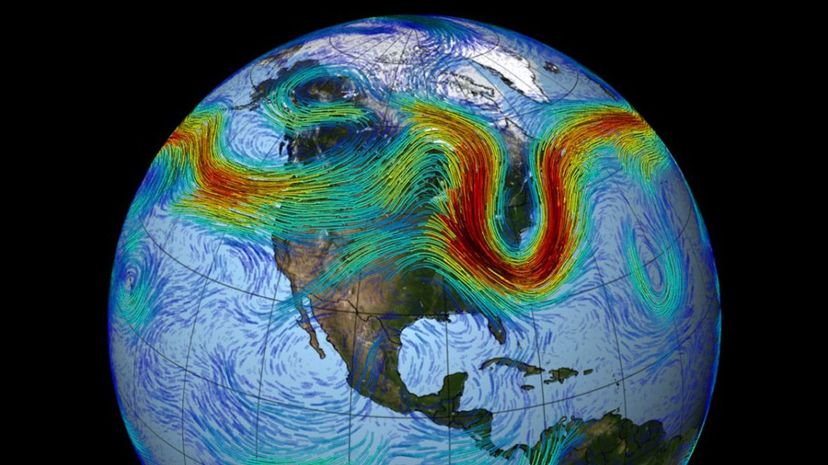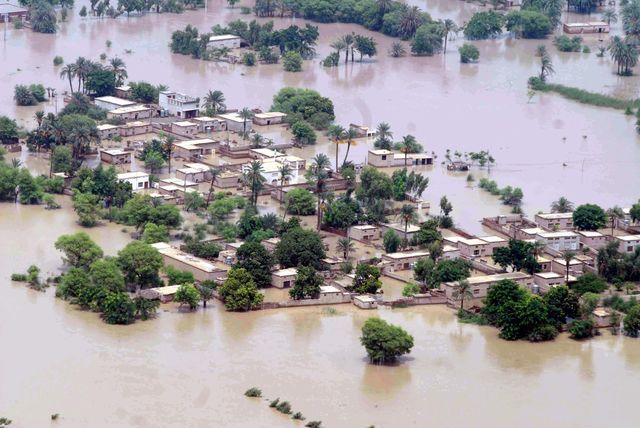
Our collective grasp on the extreme weather consequences ofclimate changeis not great. Hollywood, that great cultural litmus strip, feeds us some interesting information about the potential effects of an altered ecosystem. In the 2004 film "The Day After Tomorrow," the shutdown of the currents in the Atlantic Ocean creates a mighty superstorm that ices over the entire Northern Hemisphere. The upcoming film "Geostorm" promises tsunamis, herds of boisterous tornadoes and some sort of flame geysers that aren't currently offered on Earth's geothermal menu. Point being, most modestly informed people are awareour weather is changing, but if you ask a random person on the street what that's going to look like in their community in 10 or 50 years — most of us probably couldn't even hazard a guess.
Due to the nature of their work, climate scientists know more than the rest of us — but even they don't always agree about the ways in which climate change will affectweatherin specific places. In 2012,a controversial studychallenged previously accepted ideas about the mechanisms through which climate change will affect our weather: Warmer temperatures will result in more heat waves, hotter summers will bring worse droughts, the warmer atmosphere will hold more water, resulting in heavier precipitation and flooding. All of this might be true, but this study suggested that something else might be happening as well — that the relatively predictable flow ofEarth's weatheris changing. Due to alterations in the behavior of the jet stream, especially in the middle latitudes, weather patterns are getting "stuck" in place for longer periods, intensifying the on-the-ground effects, resulting in severe droughts, flooding and intense heat waves.
Advertisement
This idea has been controversial, partly because the leading edge of research always has its supporters and detractors. But anew studypublished in the journal Nature Scientific Reports reinforces this idea that climate change is altering the world's weather-making wind conveyor belts in a way that favors extreme and long-lasting weather anomalies. This 2012 NASA animation, created using weather and climate observations from NASA's MERRA dataset, shows a 30-day pattern in the Northern Hemisphere jet stream.
Jet streams are high atmospheric air currents that move from west to east, driven by Earth's rotation. They also happen tomake our weather. Although the winds of a jet stream's flow move in just one direction, the difference in temperature between the poles and the equator pulls these winds into north-south meandering wave patterns. But if temperatures at the poles change more rapidly than those at the equator, the dual constraints on the jet streams become imbalanced.
"Just like a coaxial cable acts as a waveguide to deliver electromagnetic waves to our televisions with minimal energy loss," says lead author Michael Mann, professor of atmospheric science at Penn State, via email, "the atmosphere tends to confine waves in the jet stream in a way that allows them to always travel with minimal energy loss."
When the temperature difference between the pole and the equator is large, the flow of the jet stream becomes stronger and the waves shorter. When the poles warm up at a faster rate than the equatorial regions do — like what's happening right now — it's most efficient for the atmospheric waves to stretch out, and for the flow to become weaker.
"These very large north-south meanders are associated with both extreme weather and weather getting stuck in place, leading to persistent regional droughts, flooding, heat waves, etc.," says Mann. "We show that climate change is making a temperature pattern that supports those conditions more common."
And you don't have to look far to find evidence of extreme weather hammering particular spots on the globe for long periods. In 2010, an intense low-pressure system in Pakistan delivered unprecedented monsoon rainsresulting inflooding — and killing 2,000 people and destroying the homes, crops and livelihoods of 18 million more. Extreme high-pressure systems associated with heat and drought have also remained stuck in place for long stretches of time, giving us events like the 2003 European heat wave, which is estimated to have caused35,000 deaths2010年,俄罗斯的热浪和野火,2011 heat wave and drought in Oklahoma and Texas, and the 2015 California wildfires, to name a few.

So, now that we're hopefully getting a better handle on how climate change might affect our lives here on the ground, Mann and his co-authors are looking at how this information can help us in the future:
"We hope this paper can inform the larger discourse over the very real risks that climate change poses to us," he says. "Secondly, there might also be the opportunity to use the information to try to predict when extreme weather events are most likely to occur."
Advertisement
